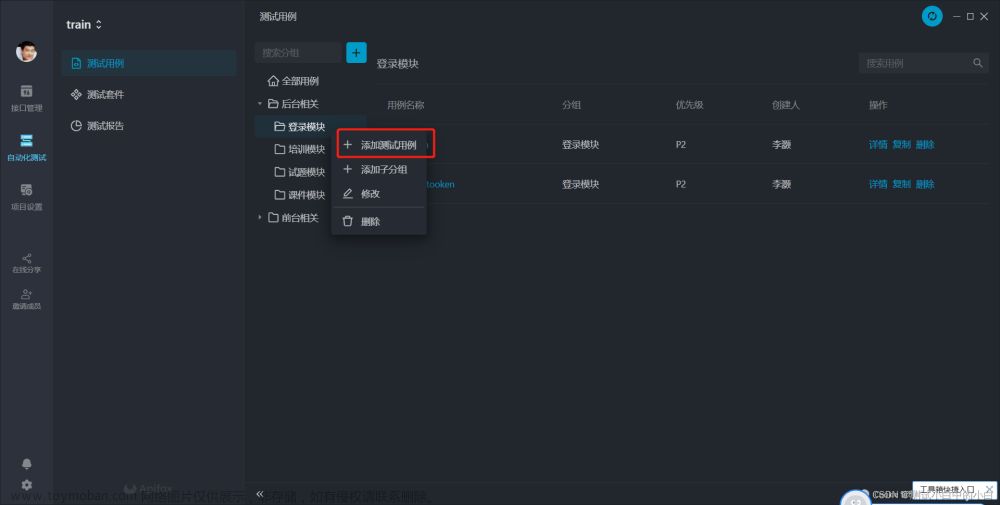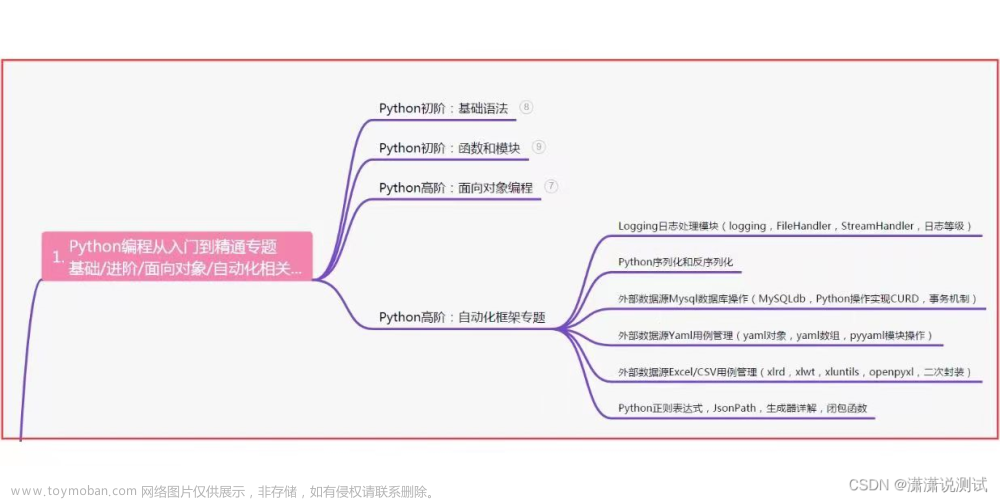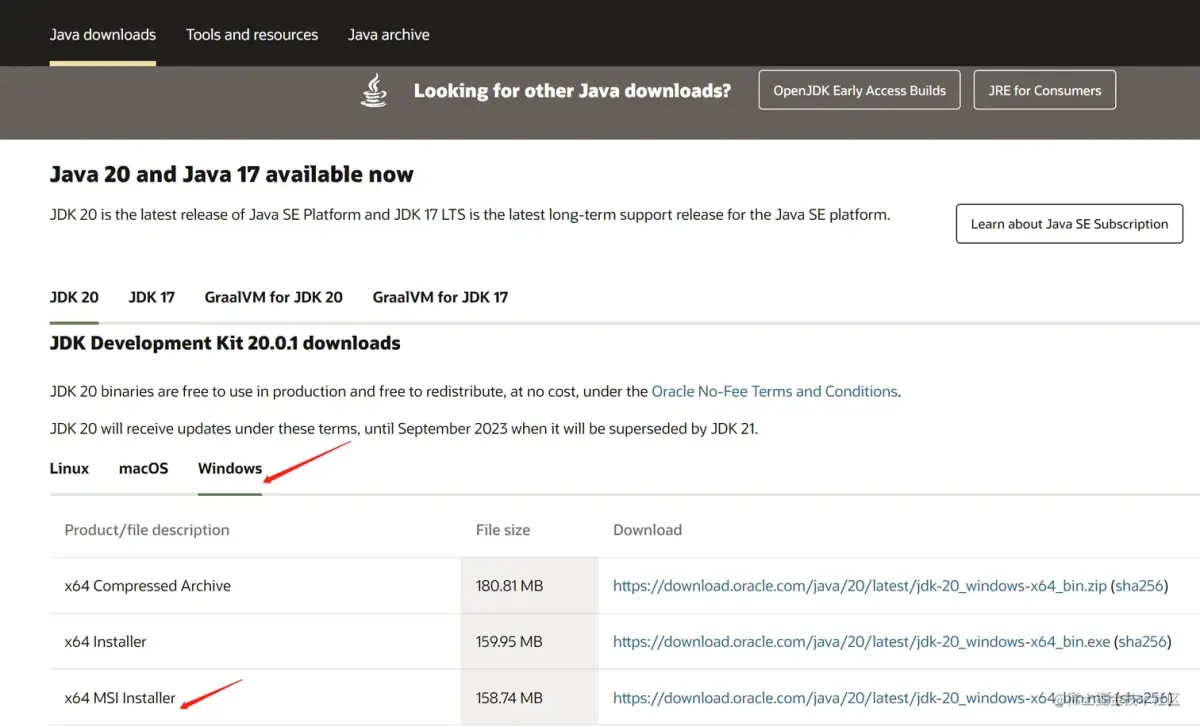在Python中,我们可以使用requests库来实现接口自动化测试,并使用unittest或pytest等测试框架来组织和运行测试套件。以下是一个基本的接口自动化测试套件封装示例:
首先,我们需要安装所需的库:
pip install requests pytest创建一个项目目录结构,如下所示:
project/
│
├── common/ # 公共方法模块
│ └── utils.py # 存放请求、断言等公共函数
│
├── conf/ # 配置模块
│ └── config.py # 存放测试环境、API基础URL等配置信息
│
├── data/ # 测试用例参数模块
│ └── test_data.json # 存放测试用例的输入数据
│
├── log/ # 日志模块
│ └── log.txt # 存放测试过程中的日志信息
│
├── report/ # 测试报告模块
│ └── report.html # 自动生成的测试报告
│
├── test_case/ # 测试用例模块
│ ├── test_login.py # 登录接口测试用例
│ ├── test_signup.py# 注册接口测试用例
│ └── ... # 其他接口测试用例
│
└── testsuite.py # 测试套件文件,用于组织和运行测试用例同时,在这我也准备了一份软件测试视频教程(含接口、自动化、性能等),需要的可以直接在下方观看就行,希望对你有所帮助!【公众号:互联网杂货铺】免费领取软件测试资料!
2024年Python自动化测试全套保姆级教程,70个项目实战,3天练完,永久白嫖...
编写各个模块的代码
common/utils.py:封装请求和断言等公共函数。
import requests
import json
def send_request(method, url, headers=None, params=None, data=None):
response = requests.request(method, url, headers=headers, params=params, data=data)
response.raise_for_status() # 如果响应状态不是200,抛出异常
return response.json()
def assert_response(response_data, expected_key, expected_value):
assert expected_key in response_data, f"Expected key '{expected_key}' not found in response."
assert response_data[expected_key] == expected_value, f"Expected value for '{expected_key}' is '{expected_value}', but got '{response_data[expected_key]}'"
conf/config.py:配置测试环境和基础URL。
TEST_ENVIRONMENT = "development"
BASE_URL = "http://localhost:8000/api/"
test_case/test_login.py:编写登录接口测试用例。
import json
from project.common.utils import send_request, assert_response
from project.conf.config import BASE_URL
class TestLogin:
def test_successful_login(self):
url = f"{BASE_URL}login"
data = {
"username": "test_user",
"password": "test_password"
}
response_data = send_request("POST", url, data=json.dumps(data))
assert_response(response_data, "status", "success")
assert_response(response_data, "message", "Logged in successfully.")
def test_invalid_credentials(self):
url = f"{BASE_URL}login"
data = {
"username": "invalid_user",
"password": "invalid_password"
}
response_data = send_request("POST", url, data=json.dumps(data))
assert_response(response_data, "status", "error")
assert_response(response_data, "message", "Invalid credentials.")testsuite.py:组织和运行测试用例。
import pytest
from project.test_case import test_login, test_signup # 导入其他测试用例模块
@pytest.mark.parametrize("test_case_module", [test_login, test_signup])
def test_suite(test_case_module):
suite = unittest.TestLoader().loadTestsFromModule(test_case_module)
runner = unittest.TextTestRunner()
results = runner.run(suite)
assert results.wasSuccessful(), "Test suite failed."运行测试套件:
pytest testsuite.py这个示例提供了一个基本的接口自动化测试套件的封装结构和代码。你可以根据实际项目的需要对其进行扩展和修改
添加更复杂的断言、错误处理、测试数据管理、报告生成等功能
更复杂的断言
在common/utils.py中,你可以添加更多的断言函数来处理更复杂的情况。例如,检查响应中的某个字段是否在预期的值列表中:
def assert_in_response(response_data, key, expected_values):
assert key in response_data, f"Expected key '{key}' not found in response."
assert response_data[key] in expected_values, f"Expected value for '{key}' to be one of {expected_values}, but got '{response_data[key]}'"错误处理
在common/utils.py的send_request函数中,你可以添加更详细的错误处理逻辑,例如捕获和记录不同类型的HTTP错误:
def send_request(method, url, headers=None, params=None, data=None):
try:
response = requests.request(method, url, headers=headers, params=params, data=data)
response.raise_for_status() # 如果响应状态不是200,抛出异常
return response.json()
except requests.exceptions.HTTPError as http_error:
logging.error(f"HTTP error occurred: {http_error}")
raise http_error
except Exception as e:
logging.error(f"Unexpected error occurred: {e}")
raise e测试数据管理
你可以创建一个单独的模块或文件来管理测试数据。例如,在data/test_data.py中定义一个字典,包含所有测试用例所需的输入数据:
LOGIN_TEST_DATA = {
"valid_credentials": {
"username": "test_user",
"password": "test_password"
},
"invalid_credentials": {
"username": "invalid_user",
"password": "invalid_password"
}
}然后在测试用例中使用这些数据:
from project.data.test_data import LOGIN_TEST_DATA
class TestLogin:
def test_successful_login(self):
url = f"{BASE_URL}login"
data = LOGIN_TEST_DATA["valid_credentials"]
response_data = send_request("POST", url, data=json.dumps(data))
assert_response(response_data, "status", "success")
assert_response(response_data, "message", "Logged in successfully.")
def test_invalid_credentials(self):
url = f"{BASE_URL}login"
data = LOGIN_TEST_DATA["invalid_credentials"]
response_data = send_request("POST", url, data=json.dumps(data))
assert_response(response_data, "status", "error")
assert_response(response_data, "message", "Invalid credentials.")报告生成
你可以使用pytest-html插件来生成HTML格式的测试报告。首先安装插件:
pip install pytest-html然后在testsuite.py中配置报告生成:文章来源:https://www.toymoban.com/news/detail-774910.html
import pytest
from pytest_html_reporter import attach_extra_css, add_context
from project.test_case import test_login, test_signup # 导入其他测试用例模块
@pytest.mark.parametrize("test_case_module", [test_login, test_signup])
def test_suite(test_case_module):
suite = unittest.TestLoader().loadTestsFromModule(test_case_module)
runner = unittest.TextTestRunner()
results = runner.run(suite)
assert results.wasSuccessful(), "Test suite failed."
if __name__ == "__main__":
pytest.main(["--html=report/report.html", "--self-contained-html"])
attach_extra_css("custom.css") # 添加自定义CSS样式
add_context({"project_name": "My API Test Project"}) # 添加上下文信息运行测试套件时,将会生成一个名为report.html的测试报告。文章来源地址https://www.toymoban.com/news/detail-774910.html
到了这里,关于接口自动化测试套件封装示例的文章就介绍完了。如果您还想了解更多内容,请在右上角搜索TOY模板网以前的文章或继续浏览下面的相关文章,希望大家以后多多支持TOY模板网!













